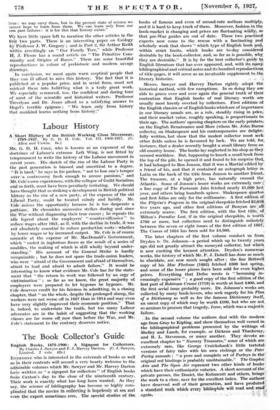The Book Collector's Guide
•
EVERYONE who is interested in the externals of books as well as in their contents will accord a very hearty welcome to the adinirable volumes which Mr. Sawyer and Mr. Harvey Darton have written as " a signpost for collectors " of English books from Caxton's day to the close of the nineteenth century. Their work is exactly what has long been wanted. As they say, the science of bibliography has become so highly com- plicated that the novice in collecting is hopelessly at sea and even the-expert sometimes errs. _ The special studies of the. books of famous and even of second-rate authors multiply, and it is hard to keep track of them. Moreover, fashion in the book-market is changing and prices are fluctuating wildly, so that pre-War guides are out of date. These 'two practised experts now come to the rescue with a fascinating and scholarly work that shows " which type of English book and, within strict limits, which books are to-day considered desirable by the book-collector, and, so far as is possible, why they are desirable." It is by far the best collector's guide te English literature that has ever appeared, and, with its: ina4 bibliographical, and critical notes and its hundred reproductions. of title-pages, it will serve as an invaluable supplement -to the; literary histories.
Messrs. Sawyer and Harvey Darton rightly adopt the: historical method, with few eXteptions. In so doing they are able to prove over and over again the general truth Of their contention that English books of real literary worth are usually most keenly coveted by collectors. First editiOna the English classics or of English books which are of importance in our literary annals are, as a rule, steadily rising in price; and their market value, roughly speaking, is proportionate to: their age. The authors' Opening chapters on the early printers,: on the English Renaissance and .More (whom Mr. John:Burns.: collects), on Shakespeare and his contemporaries are delight-1 fully written; but show that the modest collector must seek:- other fields unless he is favoured by luck. We are told, . for; instance, that a dealer recently bought a small library from an old country house. The books lay-neglected in his shop as they seemed worthless. But, happening to knock a small book from the top of the pile, he opened it and found to his surprise that it had belonged to Ben Jonson, that it was a Martial edited by a friend of his, and that it contained an autograph letter Latin on the back of the title from Jonson to another friend.. The treasure, at a high price, has naturally crossed the Atlantic. Some of Jonson's lesser works are extremely. rare a fine copy of The Fortunate Isles fetched nearly 11,000 last' year, and others bring hundreds apiece. Shakespeare cinartni: and first folios are only for the millionaire. A first editioh the Pilgrim's Progress in the original sheepskin fetched112,tilk five years ago, and other first editions of Bunyan are :alt extremely scarce. The first edition, with the first title; of Milton's Paradise Lost, if in the original sheepskin, is h: .wort £700 or more, but collectors need to distinguish mienitelY.. between the seven or eight issues of the first edition of 1967; The Cotnus of 1634 has been sold for £4,300.
. The later chapters of the first volume conduct us frimn; Dryden tc- Dr. Johnson—a period which up to twenty years, ago did not greatly attract the moneyed collector, but which is now exciting the keenest attention. Dryden's numerous_ works., the history-of which Mr. P. J. Dobell has done so much to elucidate, are now much sought after ; the fine Britwell copy, of his Mac Flecicnoe.(1q82) fetched £300 last spring„, and some of _the lesser pieces have been sold for even higher, prices. . Everything that Defoe wrote is " becoming in-. creasingly expens&e " ; a good copy of the first edition of the first part of Robinson Crusoe (1719) is worth at least £400, and the first serial issue probably more. Dr. Johnson's works are, collected by many bOoklovers, who seek eagerly for his Plan, of a Dictionary as well as for the. famous Dictionary itself,: an uncut copy of which may be worth £100, but who are not, tio anxious to procure that tragedy, Irene, which was a majestic failure. , - •_ - . - . In the second volume the authors deal :with the modern: age froin Gray- to Kipling, and show themselves well versed_ in, the bibliographical problems : presented by the writings • of) Shelley and Lamb, for example, or Dickens and Thackeray,1 and R. L. 'Stevenson, or many another. They devote an excellent chapter to " Nursery Treasures," some of which art) extremely rare, like George Cruickshank's little teetotal) versions of fairy tales with his own etchings or the-Peter Parley --annuals ; "- a pure and complete set of Parleys in -the. original red bindings is probably unobtainable." The Graphic: Arts and The Open Air represent two other kinds of :books: which have their enthusiastic votaries. A short account-of the private presses, the Daniel, the Kehnscott and others, brings the work to a close, save for the excellent index. The authors, have deserved well of their generation, and have prodtited.i a standard work which every bibliophile will read and read', again.


















































 Previous page
Previous page